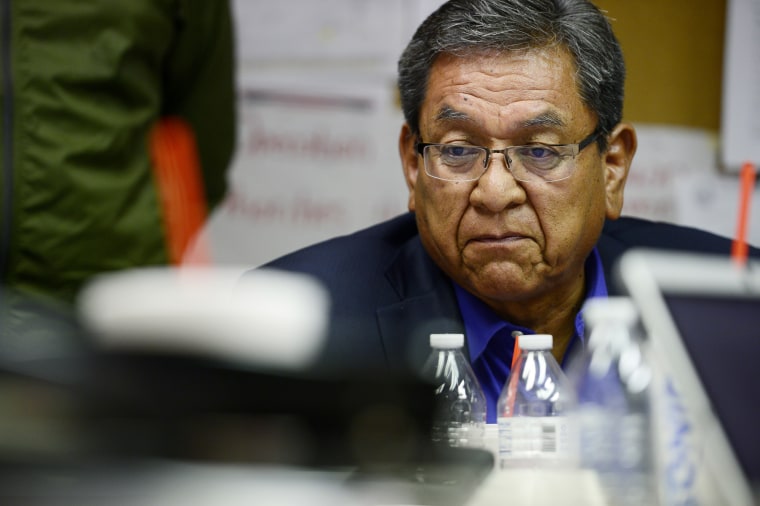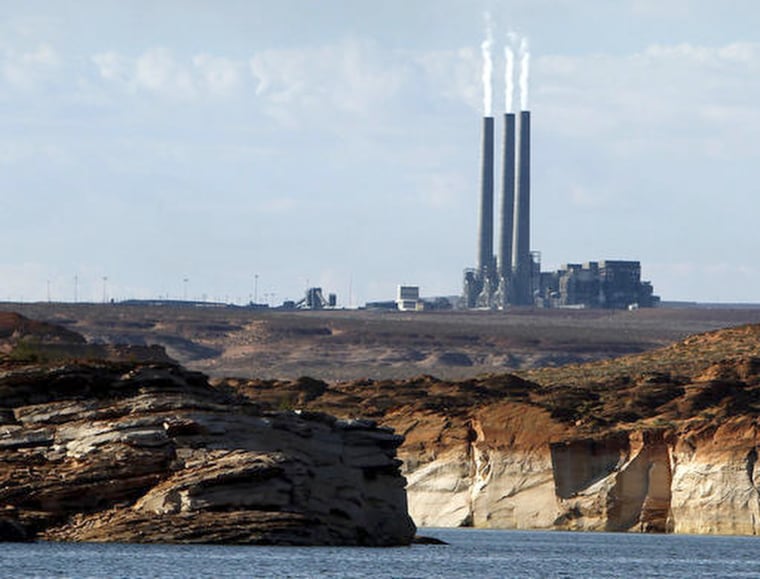A massive coal-burning Arizona power plant that has been one of the American West’s biggest electric generators — and polluters — has won a reprieve that will allow it to continue in operation for at least two more years, according to a Native American leader whose tribe is landlord for the plant.
A tentative lease extension will keep the 43-year-old Navajo Generating Station open through the end of 2019, instead of beginning a shutdown as early as this summer, Navajo Nation President Russell Begaye said at a public hearing Monday in Phoenix.
The extension is designed to give the Native American tribe that owns the land and the federal agencies that oversee the Northern Arizona plant extra time to determine whether increasingly expensive coal-generated electricity can find a market for a longer operation of the plant.

The tentative lease extension is a victory for leaders of the Navajo Nation, whose members fill many of the 800 jobs at the power plant and at the coal mine that supplies its fuel.
The agreement would also extend the flow of tens of millions of dollars of coal royalties and other payments that make up a huge portion of the tribal budgets of both the impoverished Navajo and Hopi.
The news last fall that utilities operating the plant might begin a shutdown alarmed many tribal leaders pleased environmental activists and some traditionalists within the tribes, who called for the Hopi and Navajo to bring in renewable energy facilities and other modern enterprises.
Begaye announced the apparent lease extension Monday during a "listening session" sponsored by the Department of the Interior to discuss the future of the NGS, as it is known.
"The agreement is done," Begaye told the crowded hearing room. He said the formal agreement will completed by Thursday and forwarded to the Navajo tribal council by Friday and that he, as tribal president, planned to sign it, in hope that an even longer agreement can be reached.
A spokesman for the Arizona utility that operates the plant confirmed "significant progress toward an agreement for a replacement lease." Scott Harelson of the Salt River Project (SRP) called it "possible" that the new lease would be in the hands of Navajo tribal leaders by Thursday or Friday.
SRP's leaders have called for the lease to be finalized by July 1. The two sides wanted to reach agreement in principal ahead of the deadline to allow the Navajo Nation Council and four utilities that operate the facility enough time to peruse the final draft.
Begaye said he hoped the two-year continuation of the coal-burning operation would buy time to find new operators who could keep it open even longer. "We are looking for new owners, new operators to operate through 2029," the tribal president said.
That news was greeted by a round of applause from many in the audience, including workers from the Kayenta Mine, where coal for the power plant is sourced.
Located in a scrub desert south of Lake Powell, the Navajo Generating Station produces haze that scientists say casts a pall over the Grand Canyon and 10 other national parks and wilderness areas.
The NGS, as the plant is known, is one of the nation’s largest generators of carbon dioxide, an earth-warming greenhouse gas. Activists have long complained about the health impacts of the emissions.
The lease extension could be viewed as a victory for President Trump and his administration’s goal to support expanded coal mining in the U.S. But while Trump and his interior secretary have harped on the need to reduce regulation, experts say factors outside's the government’s control are likely to be more crucial in determining whether the Arizona facility will stay open beyond 2019.
The Navajo plant has remained much in demand since its 1974 opening for its ability to produce cheap and abundant power. But many utilities, like the Department of Water and Power in Los Angeles, began to turn away from NGS’s coal-fired power as they attempted to cut carbon emissions.

The Los Angeles utility dropped its agreement to receive electricity from the Navajo plant in 2015. Nevada’s NV Energy utility has also moved away from coal-generated electricity, announcing it won’t take any more power from the Navajo facility beyond the end of 2019.
The flight away from NGS electricity has been magnified in recent times by the profusion of electricity from competing plants burning natural gas. The fuel is not only cleaner, but the advent of fracking and other new technologies has made gas-generated power much cheaper than power produced by burning coal.
The Navajo plant, which had been operating at as much as 87 percent of its full capacity as recently as 2014, saw demand slip so much that it produced just 61 percent of the maximum electricity by 2016. Experts say there is no sign the downward trend will be slowed any time soon.
While the Salt River Project and three other utilities that jointly own the power station suggest that the turn away from coal is inevitable, the company operating the mine and some tribal leaders do not agree. Coal operator Peabody commissioned a consultant, who reported in early April that the power plant could still operate profitably under a new plan, which included providing coal at a lower price.
Begaye said in an interview with NBC News that the Salt River Project and other operators had been saying as recently as a year ago that they intended to keep the power plant operating for the long term. He said that the tribe had helped provide low cost power and water (pumped with the plant’s electricity) to help turn hot Phoenix and Tucson into garden spots.
The original lease paid the tribe only "pennies on the dollar," according to Begaye, and that now the operators and officials from the Interior Department need to help repay his tribe’s long-time good faith.
“They need to go out and find new owners to continue this operation until 2029,” Begaye said.
But other tribal members said that shift should already be underway and that the Navajo need to move to alternatives immediately, rather than continue to let the power plant pollute the air and gulp up most of the 50,000 acre feet of Colorado River water the tribe is entitled to each year.
“We don’t have any other kind of development because we don’t have any water,” said Percy Deal, a leader of the environmental group Dine CARE. “Let’s get that water back and then we will have good, healthy business development.”